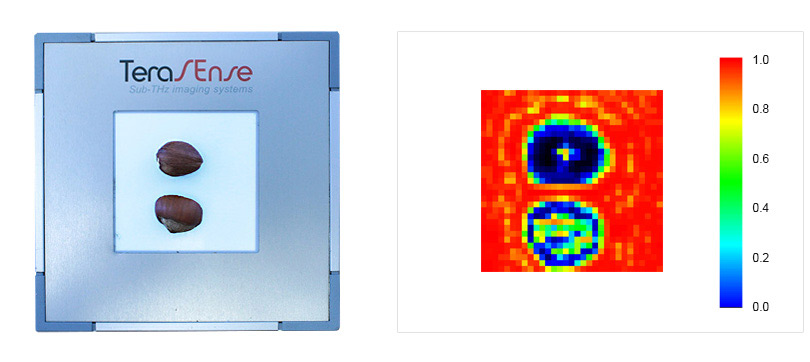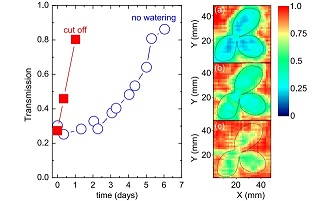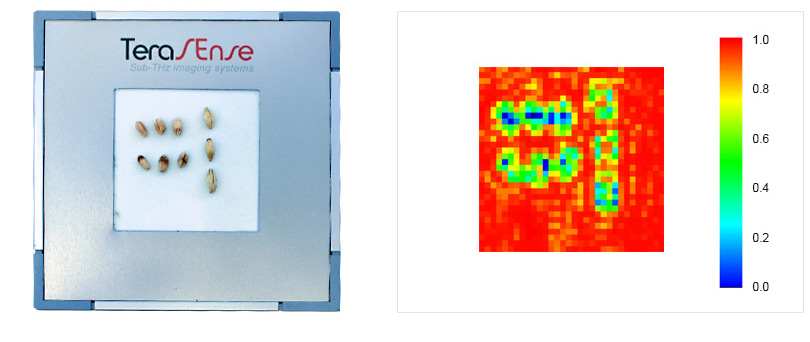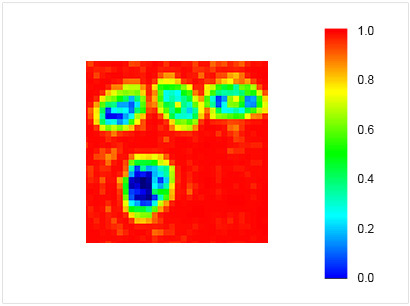Terahertz inspection of agricultural products
Lately, the Terahertz imaging systems manufactured by TeraSense are attracting an increasing amount of attention from experts in various industries. Such interest is partially attributed to a number of problems, which cannot be solved by conventional approaches based on visual, infrared and X-ray inspection methods.
These days Non-destructive testing (NDT) and non-invasive inspection statistically appear to take the lead in popularity among other applications of our Terahertz imaging technology. Of course, such important industry sectors as agriculture and its products processing are also keeping pace with modern trends aimed at realizing the great potential of our THz technology.
Terahertz inspection of nuts
Determination of the quantity and quality of nuts contained inside a nutshell is just one of the problems which Terahertz imaging systems can effectively solve. THz cameras allow identification of carcinogenic Mycotoxin fungus contaminating peanuts, corn, other grain-crops and oil-plants. In particular, with the aid of THz imagers one can detect the signs of such nut infections as Aspergillus flavus and Aspergillus parasiticus under the nutshell which exude an extremely dangerous carcinogen, Aflatoxins B1.
As an illustration of such capability, below is the Terahertz image of peanuts inside their nutshell. This THz image was taken in transmission geometry. The red color designates 100% THz transmission, green — 50%, blue — 20% at a frequency of 100 GHz. The Terahertz picture clearly shows a discernable defect — one of the nuts is missing.
 | |
| Peanut within nutshell. Visual inspection fails to identify the number of nuts inside. | Terahertz image of peanut in nutshell (100 GHz). It clearly shows a discernable defect – a missing nut on the left. |
 | |
| The same peanut without nutshell, which uncovers its internal defect – a missing nut on the left. | |
 | |
| Picture of four hazelnuts, the one on top is infected with Mycotoxin fungus. | Terahertz image of the same hazelnuts (100 GHz). It is clearly seen that the upper nut infected with fungus shows much lower transmission in THz light. |
 | |
| Similar picture, but showing hazelnuts within nutshell. | Terahertz image of hazelnuts inside nutshell (100 GHz). One can clearly see that the upper nut infected with fungus shows much lower transmission in THz light |
Related publications

Quantitative Analysis of Water Content and Distribution in Plants using Terahertz Imaging
A.V. Shchepetilnikova, A.M. Zarezin, V.M. Muravev, P.A. Gusikhina, I.V. Kukushkin.
Optical Engineering
Terahertz imaging of seeds
TeraSense is actively involved in projects that are developing equipment intended for terahertz-based qualification of grain-crops seeds (wheat, rye, rice, oats, barley, corn) and oil-plants (sunflower, soya bean, peanuts, colza). The potential tasks that Terahertz imaging devices can effectively handle includes, but is not limited to, the following:
Detection of seed availability and determination of seed structure inside a plant’s pericarp; in particular, visualization of a sugar beet seed structure.
Acidity estimation of sunflower seeds; identification of sunflower seeds infected with sclerotium fungus.
Separation of hulled and unhulled oats.
 | |
| Terahertz image of sunflower seeds (100 GHz). Sunflower seeds with increased acidity level have much lower THz transmission ratio. | |
Terahertz waste separation
Quite often agricultural processing facilities face various problems associated with separating stones, sticks, mud clots and other contaminants from the crops. However, visual inspection equipment fails to ensure an adequate level of check/verification due to the inherently low color contrast.
As an illustration, below is a Terahertz image showing THz transmission in haricot beans (the upper three items in line) and a stone (a single object in the lower part) — all fairly equal in size. We can see that stones have much higher absorption in the THz frequency range. Indeed, this property of THz light makes contaminants clearly distinguishable on the THz image.
